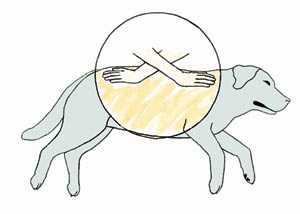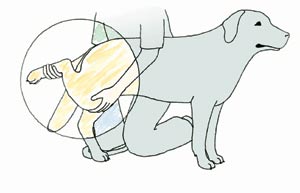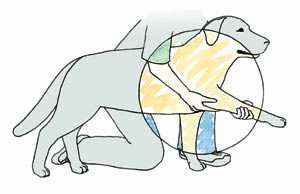| How to improve the quality of your dog’s life!
When we take on a dog we take on a responsibility which involves the everyday care of our dogs in areas such as hygiene, coat and paws, nutrition, exercise and training.
Many dog owners invest considerable time in energising their dogs by obedience training, activity seeking, tracking and protection exercises at training grounds, out in the countryside or in the forest. These activities allow us to spend time with our dogs while also keeping them physically and mentally alert. Some of us show dogs where their appearance and breed attributes are judged. Perhaps we should also pay greater attention to assessing mobility to encourage the sort of care that can spare dogs unnecessary injuries in the future. A well-functioning dog has retained its natural elasticity and suppleness.
A dog with restricted mobility has short and stiff muscles. When a dog has shortened musculature or high muscle tone, pressure is exerted on the joints leading, in turn, to decreased mobility. This ‘strangles’ the blood vessels and impairs blood circulation. Muscles, joints, tendons and ligaments then receive insufficient nutrition and less oxygen. Reduced blood flow also means that lactic acid accumulated in the muscles is not naturally transported away. The lactic acid builds up along with other waste products leading to irritation of the pain receptors in the muscles. The dog experiences pain. Pain, in turn, causes further tension and reduces blood flow even more. A vicious circle arises and can persist for some time if it is not diagnosed or recognised and treated.
Both ourselves and our dogs can suffer from short and stiff muscles if we don’t take care of our physical condition. Another illness that might reduce our dog’s mobility is Arthrosis. It is usually composed of fibrous connective tissue and cartilage and is very common in older persons or dogs, especially affecting weight-bearing joints. Articular cartilage becomes soft, frayed and thinned. But also younger persons or dogs might develop Arthrosis due to genetic reasons, injuries or the combination of overweight and too little exercise. A common symptom of Arthrosis is stiffness and lameness.
Studies on dogs have shown that regular massage and stretching over a long period can prevent and reduce the effects of Arthrosis and age related stiffness.
Warming up before activity has a preventative effect and stretching is most effective after the dog has used its muscles. The dog should have warmed up and exercised before you start to stretch the muscles and I recommend that you allow your dog to wind down after physical exertion. Let the dog walk for a while on the lead in the same way a race horse runs an extra lap at halfpace to round off the race. This helps to remove lactic acid and waste products. As with massage it is important that the dog is relaxed before you start this treatment.
Warming up can involve walking with the dog on the lead for 15 to 20 minutes before allowing it to run freely. In this way the muscles soften up and are ready for physical activity. Competitive or working dogs should warm up in a more goal-oriented way.
Below you can find a check list that might come in handy when warming up.
First remember that the dog should have warmed up and exercised before starting a competition or an active session. I also strongly recommend that you allow your dog to wind down after a competition or an active session before any stretching activities.
· Let the dog walk slowly for a while and then increase the tempo for 2-3 minutes.
· Let the dog trot for 2-3 minutes.
· Let the dog gallop for one minute.
· Then let the dog make some short explosive moves.
· Let the dog wind down a little by going back to trotting and then walking.
Warming up does not tire the dog but rather increases blood circulation and warm up the muscles ensuring that the joints are lubricated and more supple. The dog is now ready to perform.
After the warm up you could also easily test your dog’s mobility using the eight most common stretching techniques. You should be sensitive to your dog’s signals. The dog should not experience any discomfort. If it does, don’t hesitate to contact the vet.
Massage and stretching are an effective way to prevent muscle related problems and strain injuries and improve the quality of your dog’s life. Massage and stretching are a complement to daily exercise, obedience training and diet and build contact between you and your dog in a natural way. Massage is an enjoyable way of strengthening the bond with your family dog and your canine friend will love it.
After completing a competition or an active session let the dog wind down and then carefully do some stretching exercises

“Hold the dog’s elbow with one hand, grasping the wrist with the other. Move the leg forward and upwards, stretching the elbow joint and the flexor muscles of the foreleg (shoulder joint). “.

“Place one hand directly above the knee joint and the other hand on the lower part of the leg around the hock joint. Lift the leg upwards so that the knee is bent. Push gently upwards and backwards with the hand positioned above the knee joint.”
Massage relaxes the muscles and is an excellent way of letting your dog wind down after a long jogging or cycling session. And it is enjoyable! And when you come home reward the dog with massage and you will get a happy performing dog ready to take up challenges.
I now want to show you how easily you can preserve and increase mobility and reduce the risk of muscle related injuries. Here is an example of one of the basic massage techniques:

“The greater part of the pressure you exert should be applied with the flat of your hand although your thumb and fingers are also engaged in manipulation.”
Massage and stretching is an essential and a low cost investment in your dog’s health and improves the quality of your dog’s life.
Jörn Oleby, author of the book ”Canine Massage and Stretching – A Dog Owners Manual.
Illustrations used are from the book.
You can find the book at these places:
UK: www.amazon.co.uk -
USA: www.puplife.com-
South Africa: www.petspublications.co.za –
Australia: www.agilityclick.com –
Europe: www.clarksonpublishing.com |



